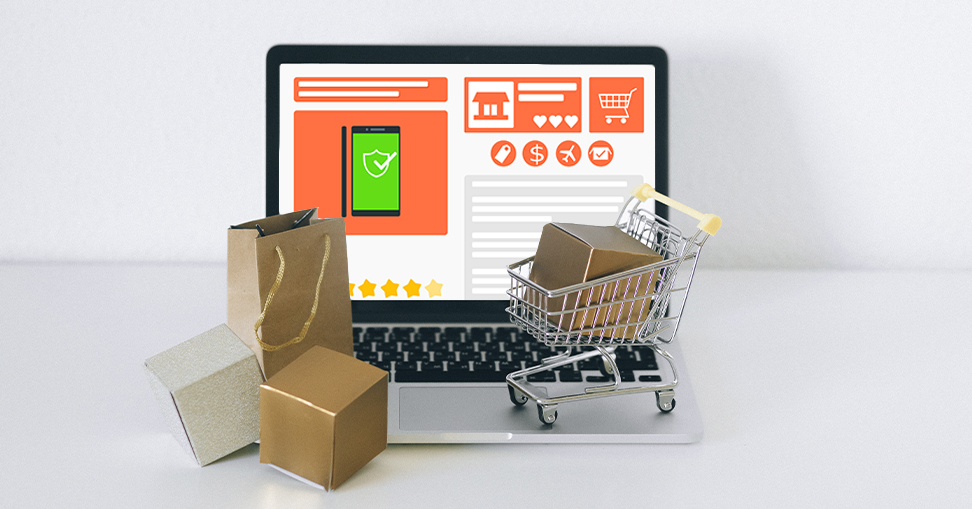The Best Tricks for E-Commerce Website Design in 2021
- Home
- The Best Tricks for E-Commerce Website Design in 2021

We do just about everything online these days, including shopping. As a result, there has never been a better time to be involved in e-commerce. Thousands of things are sold and bought online every day through a multitude of ecommerce platforms. COVID-19 has enhanced global retail, and as a result, an increasing number of business owners recognise the importance of creating a decent website that stands out from the competition so that visitors become shoppers and do not leave the online shop during the first visit.
You can expand your business, interact with more people, and sell more things with an e-commerce site, but only if you have the correct website design. When it comes to developing an e-commerce website, web design is crucial. To entice visitors to place an order, good e-commerce web design relies on the use of the proper colours, fonts, images, text and graphics. The design of your e-commerce website should appeal to potential customers, create a positive user experience and promote your store in the best light possible.
Top 8 Tips to Design a Fantastic E-Commerce Website
Let’s have a look at the most important things to think about while designing an e-commerce website.
1. Maintain a Simple Approach
We should constantly bear in mind that the simpler the design for an e-commerce website, the better the sales. Minimalism and cleanliness are two factors that make a smart e-commerce website design look more professional and organised. Additionally, ensure that your website should be designed with your target audience’s interests in mind.

2. Use High-Resolution Images and Videos
Because visitors do not have the opportunity to see the products in person, they must rely on their photo and video representations. This is a domain where brick-and-mortar retailers have an unmistakable advantage. At least for the time being. As a result, high-quality photographs and videos are essential for modern e-commerce website design. High-resolution photographs, 360-degree views, 3D models and videos are all included.
3. Prioritise Your Branding Efforts
When it comes to shopping online, customers prefer to buy from well-known companies rather than anonymous e-commerce sites that appear to be a front for stealing credit card information. Put some real thinking into your branding. If you want to develop trust, you ought to drive substantial sales with your e-commerce business. Your e-commerce business’s branding is like its DNA; it’s who you really are as a business, what you’re like, and how you’re better than the competition. It’s crucial for engaging with the audience and boosting sales.
4. Make It Responsive
We all understand the importance of having a mobile version of our e-commerce website. How many times have you used your mobile phone to look up information on a specific website rapidly? Although it may not have resulted in a purchase in almost the same way, the mobile version is significant because it is how a client views your website the most of the time.

5. Consider Yourself a Website Visitor
Put yourself in your visitor’s shoes during the design process. What kind of layout will be the most user-friendly for them? How can you organise your items such that the end consumer can understand them? How can you make the checkout process easier? You can predict what your customers want from your e-commerce store if you think like them—and then design your site to satisfy those demands.
6. Maintain the Visual Hierarchy by Emphasising It
At the top of the page, the most significant information blocks should be located. On practically any online store homepage, for example, you’ll notice the following features that assist you to comprehend what the site is all about:
- Logo and the name in the header section
- Search bar
- Navigation menu
- Contacts
- A worthy photo or slider
- A section with the main content
- Footer.
7. Ensure That Your Content is Scannable.
According to various researches, most online visitors only read about 20% of the information. As a result, it is pointless to write extensive and detailed descriptions for your e-commerce website because most customers will not read them. One suggestion is to use short sentences and paragraphs, strong letters to emphasise more significant information and huge blocks of text in lists with varying tops
8. Include Social Proof
Social proof is a great technique to build your consumers’ trust, so search for ways to display your future customers the positive feedback you’ve received from your existing customers when designing your e-commerce site.
To Sum Up
Now that you’ve read our e-commerce website design recommendations, you’ll have everything you need to create a website that looks excellent, well-organised and generates sales. If you currently have an online business, you can use these suggestions to improve it. Otherwise, just hire a reputed Shopify development company like Next Screen Infotech to make your e-commerce journey hassle-free.
Recent Posts
- Navigating Local SEO for Multi-Location Businesses: Challenges and Solutions
- Local Link Building Tactics: Building Authority and Trust for Your Business
- 10 Effective Strategies for Article Posting to Boost Your Website’s SEO
- How to Optimize Your Google My Business Listing for Local SEO Success
- Content is King: Crafting Shareable Content in the Digital Age
- Essential Strategies for E-commerce Success
- Secrets of Instagram Success: Mastering Stories, Hashtags, and Engagement
- Stand Out Locally: Supercharge Your Business with Local SEO
- The Power of E-A-T: How Google’s Algorithm Emphasizes Expertise, Authoritativeness, and Trustworthiness
- Sweet Treats, Sweet Designs: How to Make Your Sweets Boxes Stand Out